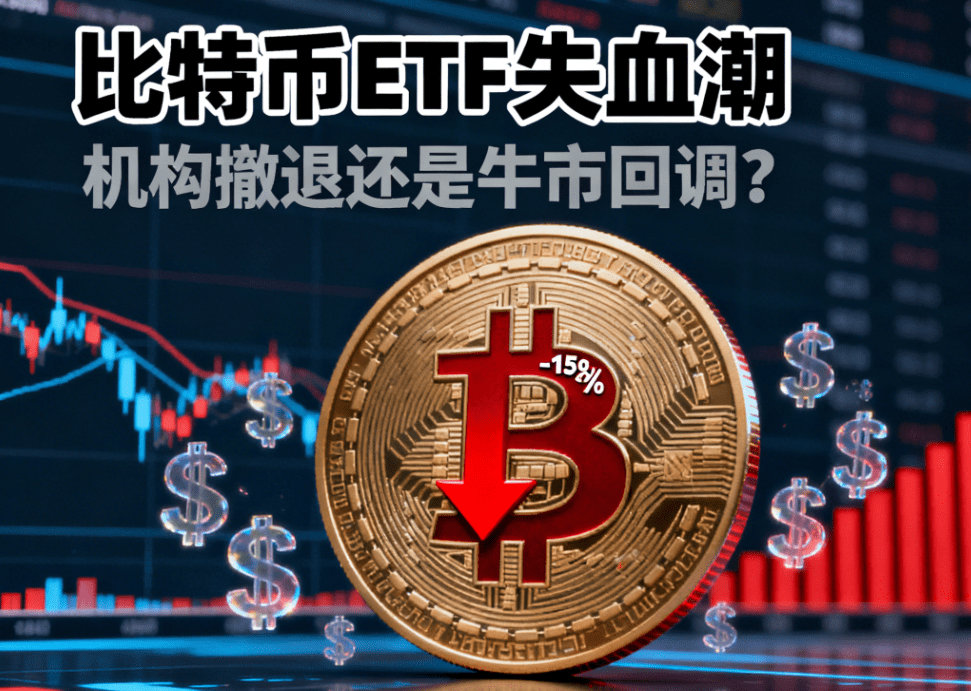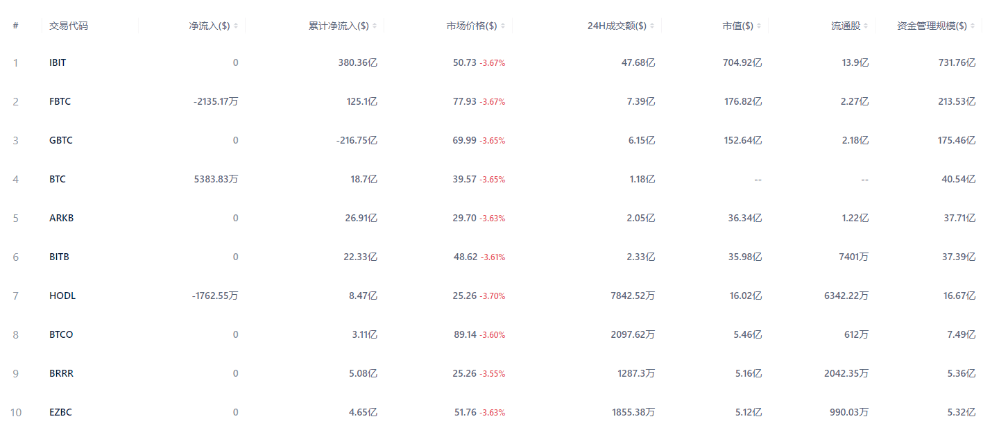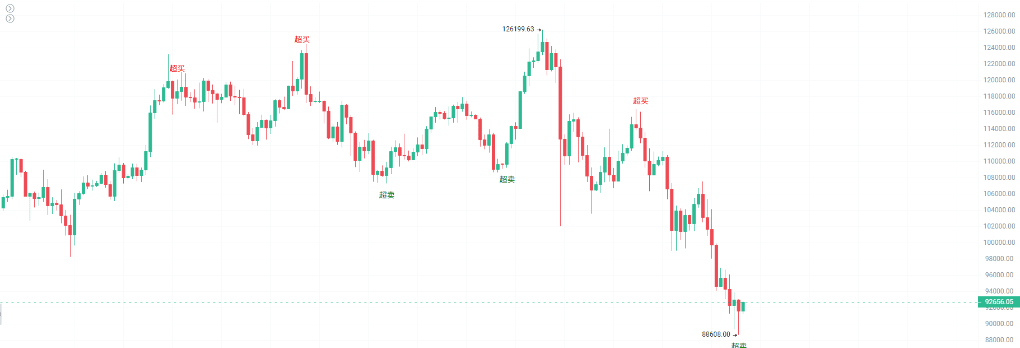Recently, the cryptocurrency market has experienced significant volatility, with Bitcoin prices falling below the $90,000 mark, and there has been a large outflow of funds from the US spot Bitcoin ETF. However, several executives from mainstream institutions have stated that this pullback is a healthy adjustment for the market and remain confident about the long-term development of the industry.
 1. Large-scale outflow of funds, led by BlackRock
1. Large-scale outflow of funds, led by BlackRock
● The US Bitcoin ETF market experienced significant outflows in November, with net outflows approaching $3 billion.
● BlackRock's iShares Bitcoin Trust (IBIT) saw a net outflow of up to $523 million on November 19, setting a record for the largest single-day outflow since the fund's launch in January 2024.
● As the largest spot Bitcoin ETF currently, IBIT has been a core force in the prosperity of crypto ETFs since its launch, but its total outflow in November has reached $2.1 billion.

Meanwhile, other major institutional products are also facing pressure from capital withdrawals:
● Fidelity's Wise Origin Bitcoin Fund experienced a net outflow of $12 million.
● ARK 21Shares Bitcoin ETF experienced a single-day outflow of $29.7 million,
● The VanEck Bitcoin Trust also recorded a net outflow of $23.3 million.

This synchronized outflow trend indicates that the current withdrawal of funds is not an isolated case, but rather a concentrated reflection of institutional investors' general caution about the short-term outlook for the market.
Second, multiple factors combined to trigger the market correction.
This cryptocurrency market adjustment has been caused by multiple factors, with changes in the macroeconomic environment being the primary factor.
● Bitcoin experienced the fourth "death cross" of this cycle last week (where the short-term price momentum indicator falls below the long-term trend). Although this is seen as a bearish technical signal, historically, this signal has sometimes also indicated a macro bottom before a strong reversal.

● Recent expectations for interest rate cuts by the Federal Reserve have significantly weakened, with the probability forecast for a cut in December dropping from about 94% a month ago to around 33%. This change in expectations has affected the attractiveness of risk assets, including Bitcoin.
● According to Kraken global economist Thomas Perfumo's analysis, the crypto market began to lose momentum in August, with a significant portion of previous demand coming from leveraged funds. At the same time, profit-taking by long-term holders has also exacerbated market pressure.
Third, institutional individuals view rationally, noting that the correction is healthy.
Faced with intense market volatility, several executives from mainstream cryptocurrency institutions expressed relatively calm and optimistic views.
● Coinbase's Head of Institutional Strategy, John D'Agostino, believes the current sell-off of Bitcoin is "healthy." He pointed out that compared to Bitcoin's historical drop of 70%-80%, this correction is relatively mild.
● D'Agostino emphasized that since the bullish environment in September, the fundamentals of cryptocurrencies have not deteriorated; rather, some important positive factors have strengthened.
A central bank in the Eurozone purchased Bitcoin;
Harvard University's endowment fund increased its exposure to Bitcoin;
Multiple mainstream banks have launched new stablecoins;
Multiple new ETFs have been approved for listing, including the Solana ETF.
He stated, "If you like this asset, then you should like it when it's on sale."
● Grayscale CEO Michael Sonnenshein also stated that it may be too early to talk about a "crypto winter," as the current observation is a very healthy correction in cryptocurrency prices.
● Sonnenshein believes that certain areas of the crypto ecosystem are experiencing too much irrational exuberance, and the current correction is beneficial for the industry to reset and consolidate in the long term; the ecosystem will become stronger after undergoing various challenges.
Fourth, regulation and innovation are the cornerstones of confidence during the growth period.
Despite poor short-term market performance, industry leaders are confident about the long-term future of cryptocurrencies.
● Grayscale's Head of Research, Zach Pandl, expressed a long-term optimistic attitude, predicting that cryptocurrency technology and assets will become part of the global financial system within the next 10 to 20 years.
● Coinbase CEO Brian Armstrong has focused on promoting a positive regulatory environment. He recently advocated for crypto market structure legislation in Washington and noted many positive developments.
● Armstrong hopes that the (CLARITY Act) can enter consideration in December and be submitted for presidential signature as soon as possible. He believes the legislation will provide clearer rules for the U.S. crypto industry, helping to unlock industry potential, protect users, and support business development.
Fifth, market outlook and investment perspective.
Regarding the future direction of the market, analysts provide different perspectives.
● Lacie Zhang, a research analyst at Bitget Wallet, pointed out that although the "death cross" is seen as a bearish signal, it may also indicate the formation of a macro bottom in the context of liquidity just beginning to stabilize.
● According to Nansen's data, "smart money" traders have increased short positions in the past 24 hours, indicating that they expect short-term declines.
● Pseudonymous analyst Bitcoiner pointed out that when the Bitcoin reserve ratio of exchanges sharply declines relative to stablecoins, it historically often indicates a significant rebound.
Currently, this ratio is at its historical low, indicating that a large amount of capital is waiting on the sidelines, a setup that has previously signaled a strong upward trend for Bitcoin.
Short-term market fluctuations are unavoidable, but the construction of industry infrastructure and regulatory frameworks is gradually improving. As Grayscale CEO Michael Sonnenshein said, "Prices do not always indicate the health of Bitcoin or other cryptocurrencies." In this intense market adjustment, focusing on fundamental indicators provides better insight into the true direction of the industry than focusing on prices themselves.
Join our community to discuss and become stronger together!
Official Telegram community: https://t.me/aicoincn
AiCoin Chinese Twitter: https://x.com/AiCoinzh
OKX benefits group: https://aicoin.com/link/chat?cid=l61eM4owQ
Binance benefits group: https://aicoin.com/link/chat?cid=ynr7d1P6Z



